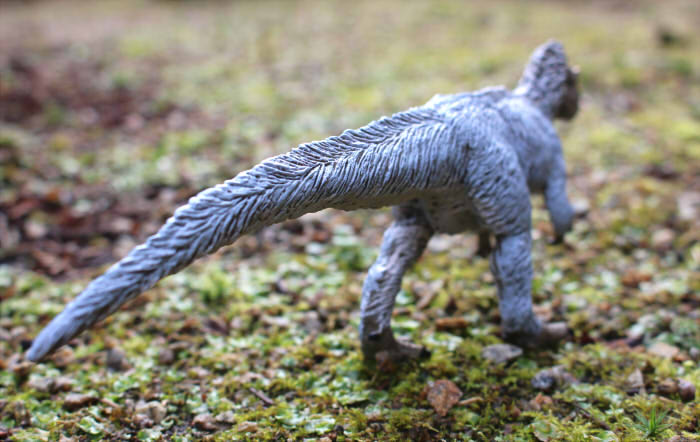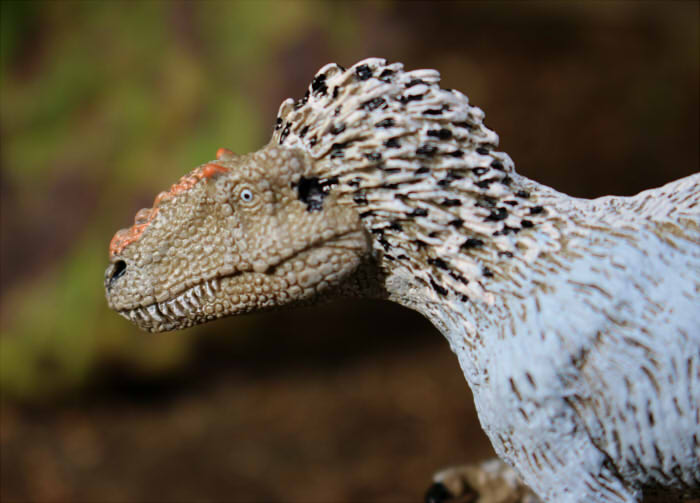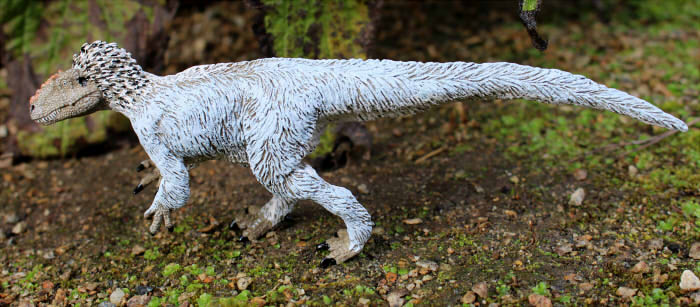Review and photographs by Tallin, edited by Plesiosauria.
Approximately 125 million years ago, Northern China had a similar temperature to today – it was cold – at least by Mesozoic standards. Indeed, the Yixian Formation of China shows that the climate of this part of early Cretaceous China would have had an average temperature of only 10°C. It is here that one of the most controversial of tyrannosaurids was discovered; the Yutyrannus. This dinosaur has caused a lot of paleontological upheaval mostly because it was found with an extensive covering of filamentous feathers. These feather impressions in the fossil were found all over the body of the animal, from the tail and neck to the arms. Yutyrannus is by far the largest dinosaur to have a proven feathery coat (whether is covered the entire body or not is still somewhat debated) at 9m long. New for 2015, Safari Ltd have released their rendition of this fearsome yet cosy beast with an almost complete covering of feathers, from a decorative maned neck to protofuzzy ankles.

In the tyrannosaurid evolutionary tree, Yutyrannus is considered to be more advanced than its relatives such as Dilong and Guanlong, but not as much so as the English Eotyrannus. This dinosaur also provided new insight into the behaviour of tyrannosaurids as two juveniles were found near an adult of the species. This could suggest that family groups stayed together, at least until the young were experienced and powerful enough for independent life, supporting other similar fossil finds. Due to the colder climate of its home, it is likely that Yutyrannus‘s feathery coat helped insulate it from low temperatures, which indicates that the evolution of simple feathers in larger dinosaurs was as a response to their environment. Related species such as Tyrannosaurus rex might not have needed them. Other traits of Yutyrannus are a crest running along the centre of the snout, and a horn like protuberance jutting a little way from the front of each eye socket.

Now to Safari ltd’s new addition to their Wild Safari line. The first and most noticeable trait is that (and ready the celebratory fizz) it stands tall on its own two feet. Even more than that, the feet are nowhere near as disproportionately large as in some of their other therapod models, and yet the Yutyrannus still stands without any instability issues. Hopefully, Safari Ltd will be able to implement this into future theropods too. A second pleasing feature is that the mouth is closed. Often, it is great fun to have a figure in mid-roar showing off a lovely set of teeth and the inside of the mouth, but when the market is dominated by bellowing therapods, it’s nice to see one with its mouth closed – after all, that’s probably how it was most of the time when the animal was alive. There is a nice fine scaly texture to the head, and the key traits of the crest and eye socket horns have been subtly incorporated. One nit-pick for me however, is that the scales of the head stop very abruptly and a fabulous back and white mane immediately blossoms. I would personally rather see more of a graduation from small feathers to big ones, but that may be down to personal taste. The figure has the correct number of fingers and toes as well as supinated hands. The muscular structure is somewhat obscured by the extensive feathers, but that’s to be expected. Once again, the feathers stop abruptly at the wrist and just past the ankle of the model which does give the impression of a scaly dinosaur in a furry suit somewhat, but only very slightly.

In terms of colouration it is clear that Safari Ltd certainly want to make reference to the cold environment this dinosaur lived in. Its feathers are very pale, a delicate icy blue covers the back, arms, legs and tail of the model and fades to snowy white on its underbelly. The mane is also white with many back flecks adorning the feathers. The whole colouration is somewhat reminiscent of the extant snowy owl. The scaly regions are coloured in sandy grey, with shiny black claws and an orangey salmon hue used to accent the head crest and ‘horns’. The small eyes are well done in ice blue with tiny black pupils. I feel that the paint application, at least on my model, lets the marvellous sculpt down a little as it is rather sloppily applied and does not have the richness in colour of the stock images at all. The black paint intended to pick out the ear has been splodged over the side of my Yutyrannus’s face and the teeth are not very well defined. This being said, however, I think this model would look stunning with a repaint, as the sculpting work is extremely sophisticated and detailed.

Overall, I think this is a very well done replica of the largest feathered dinosaur yet known. It is extremely detailed and stands firmly on its own two feet, with a great feathery texture. As a toy, I think this model would be of less interest to a child than say, a more dynamic roaring therapod figure, as the closed mouth and neutral stance make it less able to interact with other creatures and prey. Of course if the child in question is more interested in odd and unique models like this one with its fuzzy coat, it might be the perfect model for them. It could also be a great educational aid thanks to its accuracy and reflection of new discoveries. The plastic feels very strong with a slight flexibility so it shouldn’t snap easily. I find this model very interesting and a breath of fresh air from all the aggressive bellowing therapods on the market. If you want something different that reflects recent paleontological findings, this dinosaur will certainly be your cup of tea.
Available from from Amazon.com here and Ebay.com here.
Disclaimer: links to Ebay and Amazon on the DinoToyBlog are affiliate links, so we make a small commission if you use them. Thanks for supporting us!




[…] and unfortunately, there are not many versions of this unique species (there is only this one, the Wild Safari, and the Kaiyodo one). REBOR gave their model the name […]
Nice review Tallin. Yutyrannus isn’t a tyrannosaurid though, it’s a tyrannosauroid.
Ach, of course you’re right. I always confuse similar words -sigh-
With these colors of feathers and the great information provided seems the ecological equivalent of the current actual polar bear.
The link says AMAZON but it takes one to EBAY.
My mistake. I’ve updated a link to both sites now 🙂
And I should have written e-mail for typos but I didn’t look!
Please do point out any typos you spot, some will always slip through 😉
Excellent review. One little nitpick though: Yutyrannus is the *second* largest dinosaur found with feathers. Deinocheirus comes in first.
We don’t have any direct evidence that Deinocheirus had feathers. T.rex was just as likely to be feathered and it was heavier than Deinocheirus, so that still wouldn’t be correct. That’s also assuming that no big ornithischians were fluffy or feathery, which is a distinct possibility.
Deinocheirus has a pygostyle, so that makes it the largest dinosaur known to definitely have feathers.
The biggest feathered dinosaur known this far is Tyrannosaurus rex.
suspsy covered this already below – there may be feathered dinosaurs larger than Deinocheirus, such as Tyrannosaurus, but there is currently no evidence to confirm this.
Many paleontologists, including Robert Bakker, Thomas Holtz, Mark Norell, and Paul Sereno, are confident that T. rex was indeed feathered. I agree with them myself. But again, there is no direct fossil evidence to confirm this, sadly. Hopefully that will change.
What Sim said. There may well have been feathered dinosaurs larger than Deinocheirus, such as T. Rex, but no direct fossil evidence exists at present.